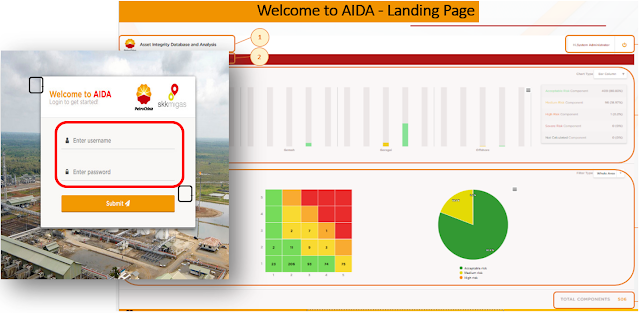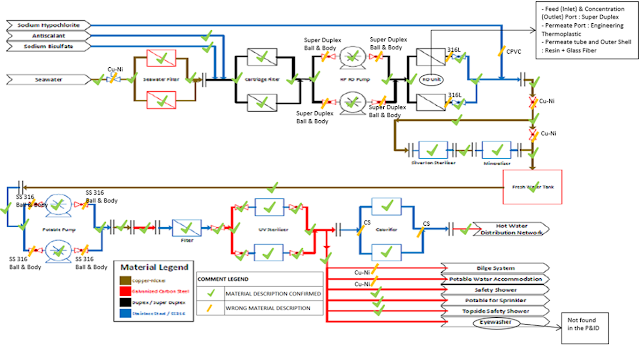The International Association of Oil & Gas Producers defines assets as facilities and associated infrastructure, e.g., structures, wells, pipelines, reservoirs, accommodation & support services [1]. Examples, such as pressure vessels, storage tanks, piping systems, associated hardware (valves, fittings, etc.), relief devices, emergency shutdown/control systems, etc.
Asset Lifecycle
Asset lifecycle according to PAS 55 is the “time interval that commences with the identification of the need for an asset and terminates with the decommissioning of the asset or any associated liabilities” [2]. In this article, the asset lifecycle in the oil and gas industry can be divided into six phases. There are design, procurement, construction, commissioning, operation, and decommissioning (Figure 1). It is necessary to know how the different phases of physical assets develop in the industry. Careful consideration should be given between short-term and long-term benefits, between risks and reward profiles, and associated costs when dealing with all stages of the asset life cycle to ensure the best value for money is achieved with asset integrity management [3], [4]. The asset lifecycle phase and its stages in the oil and gas industry are described below.
1. Design Phase
1.1 Conceptualization
This stage is used for project screening, we must conceptualize the project or the physical asset system we want to develop, identify the technical-economic viability, and set the standard for both basic engineering and detailed engineering. Activities in the conceptualization stage include identification and scoping where various initial concepts and options are considered, determination of feasibility, concept evaluation, preliminary cost estimates are undertaken, and initial risk assessments are completed. The objective of a concept study is to strategically review a number of alternative project schemes to give sufficient information to enable a go or no-go decision on whether to progress the most promising development pathway [4]–[6].
The technology, key design parameters of plants and major equipment are also defined. A list of preliminary equipment is generated, block diagrams, plant capacity, indicated layout, process flow diagrams (PFDs) for main process systems, and preliminary engineered process and utility equipment lists, also the computerized systems to be used are defined. The execution of the HAZOP (Hazard and Operability Study) is also developed, as well as determine the possible OEE (Overall Equipment Effectiveness) and RAM (Reliability Availability Maintainability) studies [4], [6].
1.2 Basic Engineering
Basic engineering or Front-End Engineering Design (FEED) defined the general guidelines and basic ideas of the project. It is undertaken to analyze the various technical options for new development with the objective of more clearly defining the project [4], [5].
During FEED a workable process design is generated, project cost is analyzed, system is identified, and the initial plot layout is proposed. For example, physical location, critical equipment, process and major equipment design specifications, one-line diagrams, process flow diagrams (PFD), utility flow diagrams, piping and instrument diagrams (P&ID), heat and material balances (HMB), plot plans, layout drawings, engineered process and utility equipment lists, single line diagrams for electrical, electrical equipment and motor schedules, vendor quotations, detailed project execution plans, resourcing and work force plans, etc., and some other flat deliverables [4]–[6].
1.3 Detail Engineering
The focus in this stage is on designing all project elements to sufficient detail so that these can be fabricated and constructed. The project team takes the FEED design and implements rigorous design calculations, safety and environmental auditing, interdisciplinary review and operability checks. At this stage we have all the details, including detailed plans and specifications, metric computations and memory of calculations, specifications and list of materials and equipment, package and strategies for contracting the construction, requirements and purchase orders of all materials, logistics and control plans [4], [5].
2. Procurement Phase
At this phase it is ensured that the purchase of materials and equipment are made in accordance with the approved supplier lists and with the specifications in the requisitions. It is where purchase orders are placed, management of quotation processes, presentation of these to the respective contracting commissions and analysis of offers [4].
Compliance with the delivery dates of equipment and materials, evaluation of the manufacture of equipment, control the traffic of materials and equipment through customs and carry out the corresponding procedures for their nationalization, store equipment and materials for the project, control the materials, in order to ensure their timely availability and carry out the reconciliation of materials once the construction is completed [4].
Inspection related to the procurement process includes certified chemical analysis of the steel or other material, physical properties of order-specific materials, including special metallurgical tests, inspection for defects in metals or other materials of construction, pressure testing, and certification by a qualified inspector to certify compliance with applicable codes [4].
3. Construction Phase
In construction phase includes a number of activities that will depend on the size of the work. It is simply to translate what is in the plans into reality, for which, execution, manufacturing, installation, inspection plans must be considered, including health, safety, and environment plans [4].
It is possible that at this phase they should make adjustments and ignore what is indicated on the plans, since the reality may be different. There are many cases that during construction modifications are made to the plans, so that there are no complications a posteriori during operations and maintenance [4].
4. Commissioning Phase
4.1 Pre-commissioning
It is the stage where the checklist, loop tests, tightness tests, among others, are carried out. This activity is normally included in an EPC (Engineering, Procurement and Construction) contract [4].
4.2 Commissioning
Once the mechanical completion during construction is complete, this stage begins and the preparation and testing for the plant commissioning is carried out, completing the checklist of the pre-commissioning stage [4].
It is important to proceed to clear the list of pending items, physical and meticulous verification of the area, comparing flow diagrams and mechanical drawings with what is installed and verify operational connections for start, stop, normal and emergency operation, checking that they have blockages, purges, corresponding vents and drains. Also verify line purging and placement of blinds (pancakes) in equipment not subject to hydrostatic tests (compressors, pumps, safety valves, others) and finally the preparation of the blind list [4].
5. Operation Phase
5.1 Start-Up
In this stage, the stable operation of the plant is achieved for a minimum time of 24 hours, culminating the initial operation period and after starting the normal operation phase. Testing the performance of the plant's equipment and systems and maintaining stable operational continuity, to analyze performance now occurs [4].
In this stage also proceed to verify the quality of the final products. Representatives of the equipment manufacturers to witness the initial operation of the equipment are present, for which it is necessary to have experienced and trained operators at startup and document all failures in case they occur, being invaluable information for operating and keep [4].
5.2 Operation and Maintenance
This is the longest phase of the asset and therefore is where the mission of a maintenance organization and its different strategies to ensure the operational continuity of physical assets is centered [4]. During the asset life cycle, the ageing process may begin ahead of an asset or component first entering services. In the operation phases, analysis of the outputs from inspection, testing, and maintenance activities enable duty holders to identify trends, respond to performance issues and identify early indicators of ageing and obsolesce [7].
The prime purpose of inspection, testing, and maintenance is to ensure that the condition of the asset is always understood and that it remains in a fit-for-purpose condition. In this stage, asset integrity related to the prevention of major incidents is very important [7]. This stage will be detailed later.
5.3 Renew
This stage is the one in which the asset is re-powered, based on major improvements and maintenance. It is normally reflected in a turnaround, the objective of which is to bring the plant to its original conditions [4].
6. Decommissioning Phase
This is the phase of decommissioning of the physical asset, a phase that is generated due to the fact that its maintenance costs are very high, or because its spare parts cannot be located since it may be obsolete equipment, among others [4].
Reksolindo Involved in the Asset Lifecycle
PT Rekayasa Solverindo (Reksolindo) has been involved in many projects in the oil and gas industry to deliver a reliable solution in the asset lifecycle phase to help minimize the risk due to material deterioration, manage asset integrity, make cost-effective run-repair-replace decisions, determine the root causes of failure and provide recommendations for improvement, resolve problems that may arise during a component's life, and many more solutions in the material engineering aspect to ensure the industry work properly. Reksolindo provides comprehensive engineering services in:
- Design Phase (Material Selection).
- Operation Phase (Integrity Management, Material Testing and Inspection, Risk Based Inspection (RBI), Fitness for Service (FFS), Remaining Life Assessment, Failure Analysis).
- Asset Integrity Training Service
Material Selection Project
Reksolindo helps to identify technically the feasible material candidates for intended services and recommend the optimum selected materials considering constructability, market availability, HSE studies, maintainability, and the track record also cost-benefit analysis.
Corrosion Assessment Project
Reksolindo provides corrosion assessment, one example is to determine the corrosion rate of pipelines regarding historical sets of In-Line Inspection (ILI) data based on Statistically Active Corrosion (SAC) assessment.
Fitness for Service (FFS) Project
Reksolindo helps to assess damage or deterioration in the structures to determine if the equipment is safe and fit for continued operation. It prevents breakdowns, minimizes risk, and makes cost-effective run-repair-replace decisions.


Risk Based Inspection (RBI) Project
Reksolindo provides RBI assessment and proper RBI software accurately & reliably as per methodology on international standards, for continual improvement in managing the integrity of the company assets. Reksolindo helps to prioritize and focus inspection efforts on items where the safety, environment or economic risks are identified as being high, and similarly to reduce the effort applied for low-risk items.


References:
[1] International Association of Oil & Gas Producer, “Asset integrity - The key to managing major incident risks,” 2018.
[2] Institute of Asset Management. and British Standards Institution., PAS 55-1: Asset Management - Part 1: Specification for the optimized management of physical assets. 2008.
[3] J. Ramasamy and S. M. Yusof, “A Literature Review of Subsea Asset Integrity Framework for Project Execution Phase,” Procedia Manuf, vol. 4, pp. 79–88, 2015, doi: 10.1016/j.promfg.2015.11.017.
[4] E. Vásquez, “Reality Centered Maintenance RCM,” 2021.
[5] M. West, “Assessment of the Engineering Design Capability and Capacity in the Oil and Gas Sector in Western Australia,” 2011.
[6] P. Christensen et al., “18R-97: Cost Estimate Classification System - As Applied in Engineering, Procurement, and Construction for the Process Industries,” 2005.
[7] J. S. Apache, D. Ritchie, I. H. Shell, D. May, and N. Pickering, “Guidance on the Management of Ageing and Life Extension for UKCS Oil and Gas Installations,” 2012.









